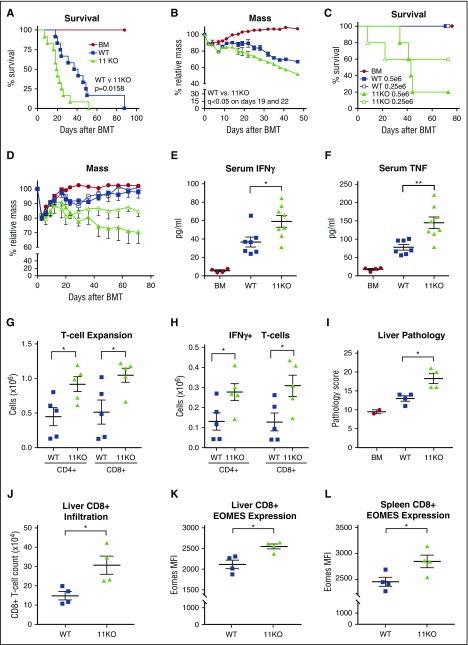Figure 5.
HDAC11KO T cells mediate more potent GVHD. BALB/c mice were irradiated with 900 cGy and transplanted with 5 × 106 WT C57BL/6 mouse BM cells depleted of T cells with/without the addition of allogeneic WT or HDAC11KO T cells. (A) Survival of mice injected with BM alone (circles), BM plus 1 × 106 WT T cells (squares), or BM plus 1 × 106 HDAC11KO T cells (triangles) is displayed. (B) Body weight relative to initiation of the experiment was also monitored. Treatment groups contained 10 mice each. Results shown are from 2 independent experiments. (C) In a similar experiment, BALB/c mice were adoptively transferred with BM plus 0.5 × 106 WT T cells (closed squares), 0.5 × 106 HDAC11KO T cells (closed triangles), 0.25 × 106 WT T cells (open squares), or 0.25 × 106 HDAC11KO T cells (open triangles), and survival was monitored. (D) Body weight relative to initiation of experiment was also evaluated. (E) Serum IFN-γ and (F) TNF levels were assessed by ELISA 12 days after adoptive transfer with BM± T cells. Treatment groups contained 8 mice each. Results shown are from 2 independent experiments. (G) Splenic CD4+ and CD8+ T-cell numbers were assessed at day 5 after BM ± T-cell transplant. (H) The number of IFN-γ expressing CD4+ and CD8+ T cells was also assessed by intracellular flow cytometry after stimulation with PMA and ionomycin. (I) Fourteen days after adoptive transfer, mice were killed, and liver pathology was evaluated. (J) The number of CD8+ T cells and (K) expression levels of EOMES by CD8+ T cells in the liver were evaluated. (L) EOMES expression in splenic CD8+ T cells was likewise evaluated. Error bars graphed are SEM. *P < .05; **P < .01. BMT, bone marrow transplant; MFI, mean fluorescence intensity.

